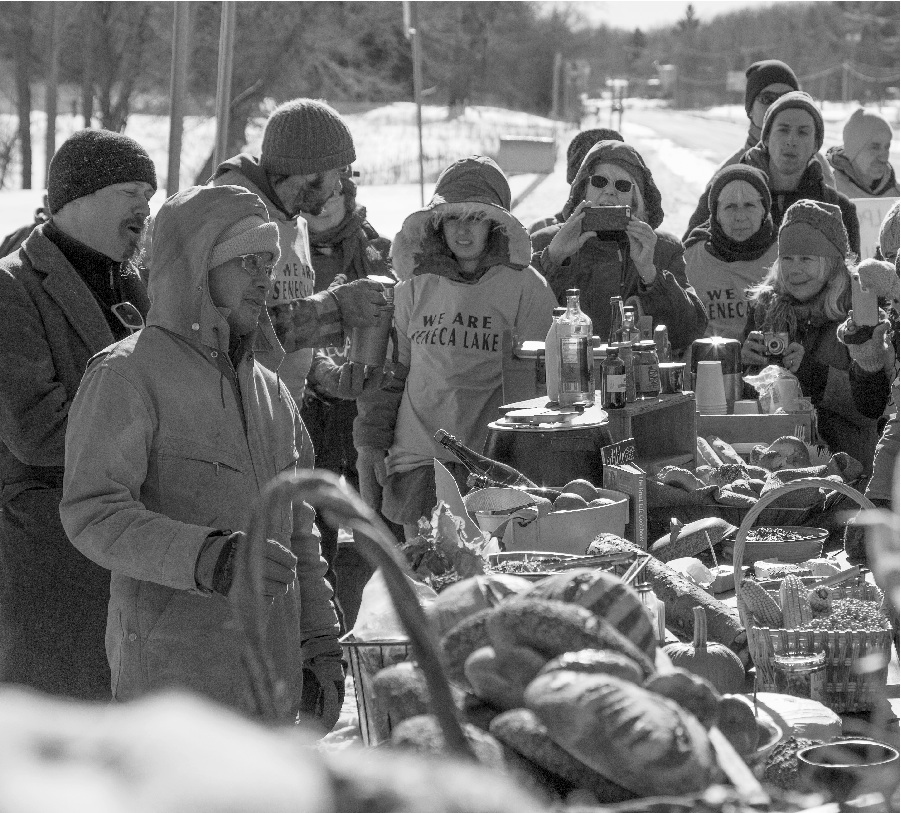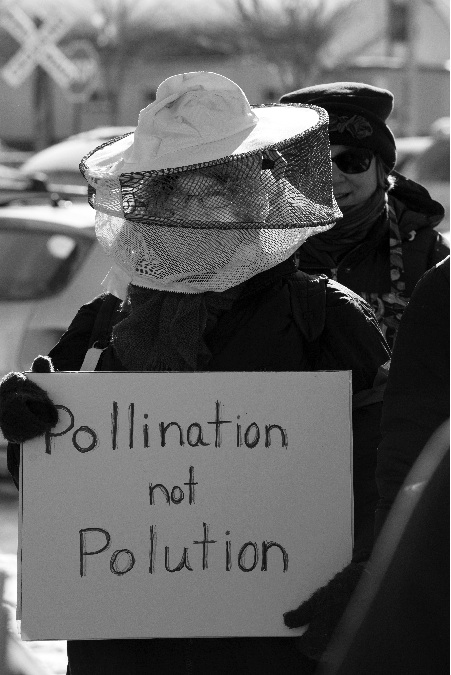 In an effort to protect the Finger Lakes’ waters and bounty from the risks posed by Crestwood Midstream’s proposed gas storage facility, local celebrity chef Emma Frisch hosted an outdoor potluck to accompany a civil disobedience action at the facility’s gates.
In an effort to protect the Finger Lakes’ waters and bounty from the risks posed by Crestwood Midstream’s proposed gas storage facility, local celebrity chef Emma Frisch hosted an outdoor potluck to accompany a civil disobedience action at the facility’s gates.
Sixty farmers, chefs, wine makers, bartenders, restaurant owners and Finger Lakes food lovers attended a Protest Banquet and Blockade at Crestwood Midstream Gate in the continuing campaign against storing highly pressurized, explosive gas in abandoned salt caverns on the west shore of Seneca Lake, despite documented instability of the salt caverns and concern over impacts to water quality and public safety.
Protesters included Food Network star Frisch, Northstar Restaurant owner Lee Hamilton and renowned organic farmer Chaw Chang.
At least 210 have been arrested since the civil disobedience campaign began. Other themed protests at the site included action to honor Pete Seeger; 13 risked arrest and successfully blockaded Crestwood all day. In January, on Martin Luther King Day, 20 were arrested in honor of the civil disobedience icon.
Crestwood is a gas storage facility on the banks of Seneca Lake. The Texas-based company plans to store pressurized methane, propane and butane in a series of old, underground salt caverns on the lake shore.
To be clear, these caverns are not sealed, contained spaces. They are eroded, underground holes created when salt was mined, a former booming industry that still continues. This process involves forcing hot water or steam down small holes drilled into a deep salt formation. The salty brine is then extracted for evaporating back into salt. Left behind is a chain of subterranean caves, the walls of which are salt and exposed shale rock.
So what’s the issue? Interbedded salt caverns have a litany of problems when used to store gas. Although only 7 percent of underground gas storage facilities in the U.S. are salt caverns, they represent 100 percent of catastrophic failures. Since 1972, all 11 instances of catastrophic failure of underground gas storage facilities have involved salt caverns.
Risks include fire, explosion, and collapse. Even absent catastrophic accident, storing pressurized gases in salt formations can push brine and gas through fissures and unseen cracks. If salt leaks into Seneca Lake, it could salinate an enormous body of water used for drinking, recreation, growing food and nurturing the vines of the areas award-winning wine region.
While blockades and protests have helped raise awareness about the hazards and mass industrialization that Crestwood brings, the group known as We are Seneca Lake feels it can have an even wider reach with a food-oriented approach to protest.

 “I believe in the age-old quote that ‘we are what we eat.’ I do not want food grown with contaminated water on my plate, and I’m committed to protecting the bounty that has defined the Finger Lakes as a wine and culinary epicenter. As a chef and business owner in this region, it’s my top priority to feed people clean, healthy food,” said Emma Frisch, co-owner of Firelight Camps. “I applied to be on television as a celebrity chef because I was inspired to take my passion for farm-to-table nationwide. I found the courage to do so by living in a community where this approach to food is not a trend, but a centuries-old way of life...and it works. It would be devastating to see the very foundation of our home destroyed.”
“I believe in the age-old quote that ‘we are what we eat.’ I do not want food grown with contaminated water on my plate, and I’m committed to protecting the bounty that has defined the Finger Lakes as a wine and culinary epicenter. As a chef and business owner in this region, it’s my top priority to feed people clean, healthy food,” said Emma Frisch, co-owner of Firelight Camps. “I applied to be on television as a celebrity chef because I was inspired to take my passion for farm-to-table nationwide. I found the courage to do so by living in a community where this approach to food is not a trend, but a centuries-old way of life...and it works. It would be devastating to see the very foundation of our home destroyed.”
The Protest Banquet and Blockade was set up along the side of the road, and included speeches, blessings, and toasts as local farmers, chefs, brewers, wine makers, bartenders, maple syrup makers, and luminaries in the world of food stood up, together, in defense of clean water, natural beauty, agriculture, local food and sustainable economic development.
The Finger Lakes region has the largest tourism economy outside of the metropolitan NYC area, with the largest spending category going to food and drink. There are about 7,000 farms in the Finger Lakes, and 4,300 households in the Ithaca and Tompkins County area alone buy their fruits and vegetables directly from farmers.
The region has over 120 wineries.